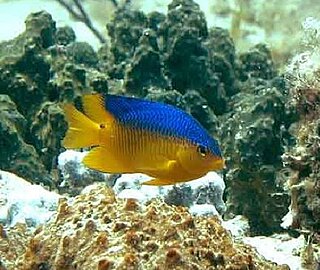
Behavioral ecology, also spelled behavioural ecology, is the study of the evolutionary basis for animal behavior due to ecological pressures. Behavioral ecology emerged from ethology after Niko Tinbergen outlined four questions to address when studying animal behaviors: What are the proximate causes, ontogeny, survival value, and phylogeny of a behavior?

Damselfish are those within the subfamilies Abudefdufinae, Chrominae, Lepidozyginae, Pomacentrinae, and Stegastinae within the family Pomacentridae. Most species within this group are relatively small, with the largest species being about 30cm in length. Most damselfish species exist only in marine environments, but a few inhabit brackish or fresh water. These fish are found globally in tropical, subtropical, and temperate waters.

The blue-footed booby is a marine bird native to subtropical and tropical regions of the eastern Pacific Ocean. It is one of six species of the genus Sula – known as boobies. It is easily recognizable by its distinctive bright blue feet, which is a sexually selected trait and a product of their diet. Males display their feet in an elaborate mating ritual by lifting them up and down while strutting before the female. The female is slightly larger than the male and can measure up to 90 cm (35 in) long with a wingspan up to 1.5 m (5 ft).
Parent–offspring conflict (POC) is an expression coined in 1974 by Robert Trivers. It is used to describe the evolutionary conflict arising from differences in optimal parental investment (PI) in an offspring from the standpoint of the parent and the offspring. PI is any investment by the parent in an individual offspring that decreases the parent's ability to invest in other offspring, while the selected offspring's chance of surviving increases.

Parental investment, in evolutionary biology and evolutionary psychology, is any parental expenditure that benefits offspring. Parental investment may be performed by both males and females, females alone or males alone. Care can be provided at any stage of the offspring's life, from pre-natal to post-natal.

Pipefishes or pipe-fishes (Syngnathinae) are a subfamily of small fishes, which, together with the seahorses and seadragons, form the family Syngnathidae.

Abudefduf, also known as the sergeant-majors, is a genus of fish in the family Pomacentridae.

Cannibalism is the act of consuming another individual of the same species as food. Cannibalism is a common ecological interaction in the animal kingdom and has been recorded in more than 1,500 species. Human cannibalism is well documented, both in ancient and in recent times.

In animals, infanticide involves the intentional killing of young offspring by a mature animal of the same species. Animal infanticide is studied in zoology, specifically in the field of ethology. Ovicide is the analogous destruction of eggs. The practice has been observed in many species throughout the animal kingdom, especially primates but including microscopic rotifers, insects, fish, amphibians, birds and mammals. Infanticide can be practiced by both males and females.

Parental care is a behavioural and evolutionary strategy adopted by some animals, involving a parental investment being made to the evolutionary fitness of offspring. Patterns of parental care are widespread and highly diverse across the animal kingdom. There is great variation in different animal groups in terms of how parents care for offspring, and the amount of resources invested by parents. For example, there may be considerable variation in the amount of care invested by each sex, where females may invest more in some species, males invest more in others, or investment may be shared equally. Numerous hypotheses have been proposed to describe this variation and patterns in parental care that exist between the sexes, as well as among species.
Mate desertion occurs when one or both parents abandon their current offspring, and thereby reduce or stop providing parental care. Often, by deserting, a parent attempts to increase breeding opportunities by seeking out another mate. This form of mating strategy behavior is exhibited in insects, birds and mammals. Typically, males are more likely to desert, but both males and females have been observed to practice mate desertion.

The yellowtail damselfish is a species of damselfish native to tropical areas such as the Caribbean coast of Panama. Damselfish are abundant in coral reef environments. The International Union for Conservation of Nature lists this fish as being of “least concern”. The species is exploited on a minor scale, for fisheries and the aquarium trade. It may be threatened by the invasive lionfish.

The mango tilapia is a species of fish from the cichlid family that is native to fresh and brackish waters in Africa and the Levant. Other common names include Galilaea tilapia, Galilean comb, Galilee St. Peter's fish, and St. Peter's fish. This is a relatively large cichlid at up to 41 centimetres (16 in) in total length and about 1.6 kilograms (3.5 lb) in weight. It is very important to local fisheries and the species is also aquacultured.
Rhynocoris tristis is a species of assassin bug family (Reduviidae), in the subfamily Harpactorinae. R. tristis is a polyphagous predator found in sub-Saharan Africa.

The broadnosed pipefish or deepnosed pipefish is a fish of the family Syngnathidae. It is native to the Eastern Atlantic from Vardø in Norway, Baltic Sea and the British Isles at north to Morocco at south. It is also found in the Mediterranean Sea, Black Sea and Sea of Azov. It is common in the coastal shallow waters, usually on reefs with seagrasses. This species is notable for its "broad" snout, which is as deep as its body.
Filial cannibalism occurs when an adult individual of a species consumes all or part of the young of its own species or immediate offspring. Filial cannibalism occurs in many species ranging from mammals to insects, and is especially prevalent in various species of fish. The exact evolutionary purpose of the practice in those species is unclear and debated among zoologists, though there is consensus that it may have, or may have had at some point in species' evolutionary history, certain evolutionary and ecological implications.

Belostoma flumineum is a North American species of giant water bug. They are a common predator in ponds and wetlands. They are relatively large, reaching 2–2.5 cm (0.79–0.98 in) in length. As with other species of the Belostomatidae family, the fathers take care of the offspring. Exclusive paternal care has been the focus of many studies done on this species. Other studies have been done on food webs and predation pressure using this species because they are an apex predator in their preferred habitats.

Abudefduf troschelii, the Pacific sergeant major or Panama sergeant major, is a species of damselfish belonging to the family Pomacentridae that can be identified by the pronounced black stripes on the lateral sides of the fish. Its specific name honors the zoologist Franz Hermann Troschel (1810-1882). It is native to the neritic pelagic zone of the shallow water coral reefs in the Eastern Pacific Ocean and they are an omnivorous species feeding on plankton and algae attached to their coral habitat. Abudefduf troschelii is a sister-species of A. saxatilis but have diverged from each other since the uplift of the isthmus of Panama, separated by the rise of the Panama land bridge 3.1 to 3.5 million years ago. Males, like in many other marine species, take care of and defend newborn A. troschelii after they have been hatched by eggs from the female. There are currently no major threats to the species and there is no indication of a current decline in its population size. The IUCN Red List lists this damselfish as being of “least concern”.

Parental care refers to the level of investment provided by the mother and the father to ensure development and survival of their offspring. In most birds, parents invest profoundly in their offspring as a mutual effort, making a majority of them socially monogamous for the duration of the breeding season. This happens regardless of whether there is a paternal uncertainty.

Pardosa pseudoannulata, a member of a group of species referred to as wolf-spiders, is a non-web-building spider belonging to the family Lycosidae. P. pseudoannulata are wandering spiders that track and ambush prey and display sexual cannibalism. They are commonly encountered in farmlands across China and other East Asian countries. Their venom has properties that helps it function as an effective insecticide, and it is, therefore, a crucial pesticide control agent.

















